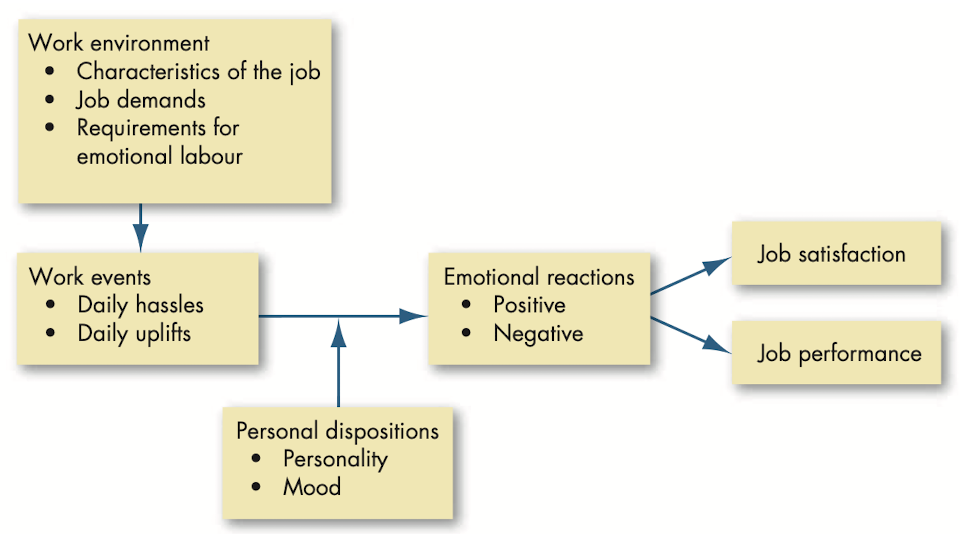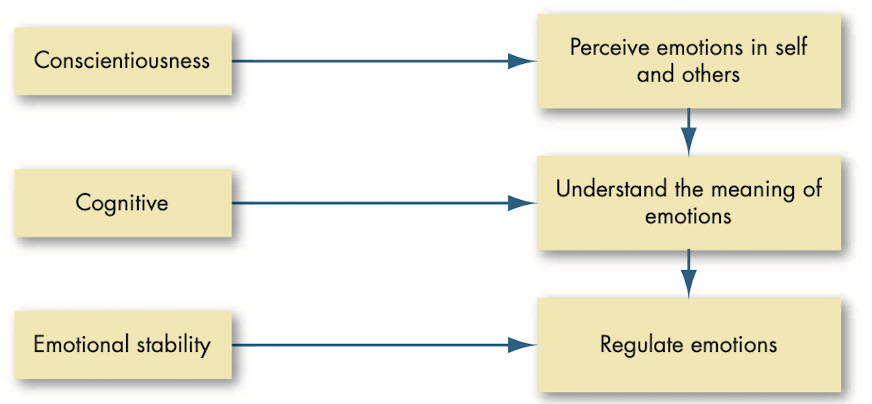Chapter 8 - Emotions & moods
What are emotions and moods?
- @@Affect@@: broad range of feelings that people experience.
- @@Emotions@@: intense feelings that are directed at someone/something.
- @@Moods@@: feelings that tend to be less intense than emotions and that lack a contextual stimulus.
- @@Positive affect@@: mood dimension that consists of specific positive emotions such as excitement, self-assurance and cheerfulness at the high end and boredom, sluggishness and tiredness at the low end.
- @@Negative affect@@: mood dimensions that consists of emotions such as nervousness, stress and anxiety at the high end and relaxation, tranquility and poise at the low end.
- @@Positivity offset@@: tendency of most individuals to experience a mildly positive mood at zero input (when nothing in particular is going on).
- @@Evolutionary psychology@@: area of inquiry which argues that we must experience the emotions we do because they serve a purpose.
- Sources of emotions and moods
- @@Personality@@
- Affect intensity: individual differences in the strength with which individuals experience their emotions.
- @@Time of the day@@
- @@Day of the week@@
- @@Weather@@
- Illusory correlation: tendency of people to associate two events when in reality there is no connection.
- @@Stress@@
- @@Social activities@@
- @@Exercise@@
- @@Age@@
- @@Gender@@
Emotional labour
- @@Emotional labour@@: situation in which an employee expresses organizationally desired emotions during interpersonal transactions at work.
- @@Emotional dissonance@@: inconsistencies between the emotions people feel and the emotions they project.
- @@Felt emotions@@: individual’s actual emotions.
- @@Displayed emotions@@: emotions that are organizationally required and considered appropriate in a given job.
- @@Surface acting@@: hiding one’s inner feeling and forgoing emotional expressions in response to display rules.
- @@Deep acting@@: trying to modify one’s true inner feelings based on display rules.
Affective events theory (AET)
@@Affective events theory (AET)@@: model which suggests that workplace events cause emotional reactions the part of employees, which then influence workplace attitudes and behaviors.

Emotional intelligence (EI)
@@Emotional intelligence (EI)@@: ability to detect and to manage emotional cues and information.

Emotion regulation
- Strategies for emotion regulation and their likely effects
- Being able to identify and modify the emotions you feel
- Strategies include acknowledgement rather than suppressing our emotional response
- Re-evaluating events as they occur
- Venting is another technique (expressing emotions outwardly).
OB applications of emotions and moods
- Selection → emotional intelligence (EI) is a factor that employers should consider when hiring especially when there is a high level of social interaction involved.
- Decision-making → positive moods and emotions help when decision making, depends but a recent study says negative moods are worse when making decisions.
- Creativity → people in good moods tend to be more creative than people in bad moods, they produce more original ideas, more flexible and open in thinking.
- Motivation → organizations that promote positive moods are likely to have more motivated workers.
- Leadership → effective leaders rely on emotional appeal to help convey their messages, expression of emotions in speeches is often the critical element that makes us accept or reject a leaders message.
- Negotiation → negotiation is an emotional process, skilled negotiator has a “poker face”.
- Customer service → workers emotional state influences customer service, influences level of repeat business and level of customer satisfaction.
- @@Emotional contagion@@: process by which people’s emotions are caused by the emotions of others.
- Job attitudes → people who have a good day at work tend to be in a better mood that evening at work.
- Deviant workplace behaviors → violating established norms provoke negative emotions, people who feel negative emotions are more likely to participate in short-term deviant workplace behaviors.
- Safety and injury at work → employers might improve health and safety by ensuring that workers are engaged in potentially dangerous activities when they are in a bad mood.
- How managers can influence moods → managers can use humor and give their employees small tokens of appreciation for work well done.